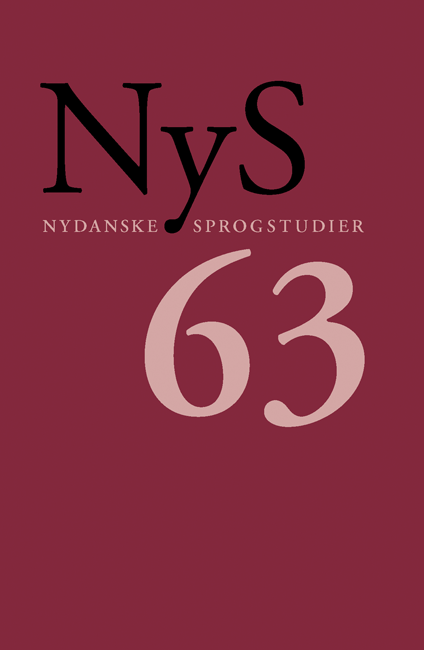Påvisning af ordblindhed ud fra eye tracking-optagelser på dansk
DOI:
https://doi.org/10.7146/nys.v1i63.137560Nøgleord:
eye tracking, maskinlæring, ordblindhed, læsevanskeligheder, psykolingvistikReferencer
Asvestopoulou, T. et al. 2019. DysLexML: Screening Tool for Dyslexia Using Machine Learning. DOI: https://doi.org/10.48550/arXiv.1903.06274.
Bellocchi, S. et al. 2013. I can read it in your eyes: What eye movements tell us about visuo-attentional processes in developmental dyslexia. Research in Developmental Disabilities 34(1). 452–460. DOI: https://doi.org/10.1016/j.ridd.2012.09.002.
Biscaldi, M., Gezeck, S., & Stuhr, V. 1998. Poor saccadic control correlates with dyslexia. Neuropsychologia 36(11). 1189–1202. DOI: https://doi.org/10.1016/S0028-3932(97)00170-X.
Björnsson, C. 1968. Läsbarhet. Stockholm, Sverige: Liber.
Børne- og Undervisningsministeriet. (2021). Systematisk test af voksne ordblinde halter efter børn og unge. Børne- og Undervisningsministeriet. 5. oktober 2021. https://www.uvm.dk/aktuelt/nyheder/uvm/2021/okt/211005-systematisk-test-afvoksne-ordblinde-halter-efter-boern-og-unge (tilgået 20. december 2022).
Center for Læseforskning, Københavns Universitet, Institut for Uddannelse og Pædagogik, Socialstyrelsen, & Undervisningsministeriet. 2020. Vejledning til Ordblindetesten (version 8). Børne- og Undervisningsministeriet.
De Luca, M. er al. 1999. Eye movement patterns in linguistic and non-linguistic tasks in developmental surface dyslexia. Neuropsychologia 37(12). 1407–1420. DOI: https://doi.org/10.1016/S0028-3932(99)00038-X.
Eckert, M. 2004. Neuroanatomical markers for dyslexia: a review of dyslexia structural imaging studies. The Neuroscientist 10(4). 362–371. DOI: https://doi.org/10.1177/1073858404263596.
Fischer, B., & Weber, H. 1990. Saccadic reaction times of dyslexic and age-matched normal subjects. Perception 19(6). 805–818. DOI: https://doi.org/10.1068/p190805.
Henderson, J. M.2013. Eye movements. D. Reisberg (red.), The Oxford Handbook of Cognitive Psychology, 69–82. Oxford University Press. DOI: https://doi.org/10.1093/oxfordhb/9780195376746.013.0005.
Hollenstein, N., Barrett, M., & Björnsdóttir, M. 2022. The Copenhagen Corpus of Eye Tracking Recordings from Natural Reading of Danish Texts. DOI: https://doi.org/10.48550/arXiv.2204.13311.
Hyönä, J., & Olson, R. K. 1995. Eye fixation patterns among dyslexic and normal readers: effects of word length and word frequency. Journal of Experimental Psychology: Learning, Memory, and Cognition 21(6). 1430–1440. DOI: https://doi.org/10.1037/0278-7393.21.6.1430.
Jensen, K. L., Gellert, A. S., & Elbro, C. 2014. Rapport om udvikling og afprøvning af selvtest af læsning – en selvtest af voksnes læsefærdigheder på nettet. Center for Læseforskning, Københavns Universitet.
Kaisar, S. 2020. Developmental dyslexia detection using machine learning techniques: A survey. ICT Express 6(3). 181–184. DOI: https://doi.org/10.1016/j.icte.2020.05.006.
Nergård-Nilssen, T., & Eklund, K. 2018. Evaluation of the psychometric properties of “the Norwegian screening test for dyslexia”. Dyslexia 24(3). 250–262.
Nilsson Benfatto, M. et al. 2016. Screening for dyslexia using eye tracking during reading. PLOS ONE 11(12). DOI: https://doi.org/10.1371/journal.pone.0165508.
Ottosen, H. F. et al. 2022. Identifying dyslexia at the university: assessing phonological coding is not enough. Annals of Dyslexia 72(1). 147–170.
Perera, H., Shiratuddin, M.F., & Wong, K.W. 2018. Review of EEG-based pattern classification frameworks for dyslexia. Brain Informatics 5(2). 1–14. DOI: https://doi.org/10.1186/s40708-018-0079-9.
Pirozzolo, F.J., & Rayner, K. 1979. The neural control of eye movements in acquired and developmental reading disorders. Studies in Neurolinguistics. 97–123. DOI: https://doi.org/10.1016/B978-0-12-746304-9.50009-4.
Płużyczka, M. 2018. The first hundred years: A history of eye tracking as a research method. Applied Linguistics Papers 25/4. 101–116. DOI: https://doi.org/10.32612/uw.25449354.2018.4.pp.101-116.
Prabha, A. J., & Bhargavi, R. 2020. Predictive model for dyslexia from fixations and saccadic eye movement events. Computer Methods and Programs in Biomedicine 195. DOI: https://doi.org/10.1016/j.cmpb.2020.105538.
Raatikainen, P. et al. 2021. Detection of developmental dyslexia with machine learning using eye movement data. Array 12. DOI: https://doi.org/10.1016/j.array.2021.100087.
Rauschenberger, M. et al. 2017. Towards the prediction of dyslexia by a web-based game with musical elements. Proceedings of the 14th International Web for All Conference. 1–4). DOI: https://doi.org/10.1145/3058555.3058565.
Rayner, K. 1986. Eye movements and the perceptual span in beginning and skilled readers. Journal of Experimental Child Psychology 41(2). 211–236. DOI: https://doi.org/10.1016/0022-0965(86)90037-8.
Rayner, K. 1998. Eye movements in reading and information processing: 20 years of research. Psychological Bulletin 124(3). 372–422. DOI: https://doi.org/10.1037/0033-2909.124.3.372.
Rello, L., & Ballesteros, M. 2015. Detecting readers with dyslexia using machine learning with eye tracking measures. Proceedings of the 12th International Web for All Conference. 1–8. DOI: https://doi.org/10.1145/2745555.2746644.
Rubino, C., & Minden, H. 1973. An analysis of eye-movements in children with a reading disability. Cortex: A Journal Devoted to the Study of the Nervous System and Behavior. DOI: https://doi.org/10.1016/S0010-9452(73)80030-9.
Schulte-Körne, G. 2010. The prevention, diagnosis, and treatment of dyslexia. Deutsches Ärzteblatt International 107(41)- 718–726. DOI: https://doi.org/10.3238/arztebl.2010.0718.
Singleton, C., Horne, J., & Simmons, F. 2009. Computerised screening for dyslexia in adults. Journal of Research in Reading 32(1). 137–152. DOI: https://doi.org/10.1111/j.1467-9817.2008.01386.x.
Smyrnakis, I. 2017. Radar: A novel fast-screening method for reading difficulties with special focus on dyslexia. PLOS ONE 12(8). DOI: https://doi.org/10.1371/journal.pone.0182597.
Stanek, H. 2021. Kritiske læsevejledere: National test fanger ikke alle ordblinde blandt de yngste elever. Folkeskolen. 10. december 2021. https://www.folkeskolen.dk/danskundervisning-ordblindlaesesvag-skolepolitik/kritiske-laesevejledere-national-test-fanger-ikke-alle-ordblinde-blandt-de-yngste-elever/2071880 (tilgået 20. december 2023).
Downloads
Publiceret
Citation/Eksport
Nummer
Sektion
Licens
Forfatteren/forfatterne og NyS har ophavsret til de artikler og anmeldelser der bringes i tidsskriftet. NyS har ophavsretten til den udgivne version af tidsskriftet. Forfatteren har ophavsretten til sin egen tekst. Forfattere kan arkivere den publicerede artikel på deres institutions forskningsarkiv (Institutional Repository) eller en privat hjemmeside, når forfatteren samtidig linker til artiklen med den officielle DOI.
For artikler publiceret i NyS tillades at læsere kan downloade, kopiere, udskrive, søge eller linke til og citere fra artikler til ethvert lovligt formål. Artikler kan frit deles og linkes til på forsknings- og undervisningsnetværk (så som Blackboard, Moodle, Canvas o.a.). Link foretrækkes fordi det giver oplysning om brug af tidsskriftets artikler, og fordi det anerkender tidsskriftets redaktionelle arbejde. NyS tillader ikke at læsere bruger artikler eller dele af dem i egne artikler uden at citere, eller at læsere på anden vis anvender dem til kommercielle formål.





